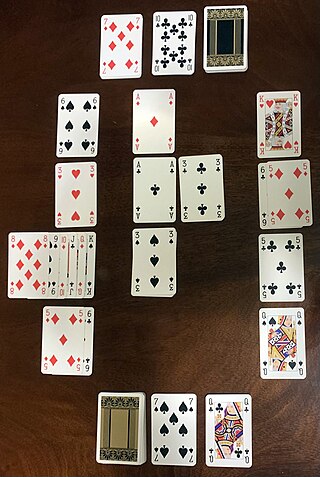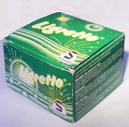
Games of patience, or (card) solitaires as they are usually called in North America, have their own 'language' of specialised terms such as "building down", "packing", "foundations", "talon" and "tableau". Once learnt they are helpful in describing, succinctly and accurately, how the games are played. Patience games are usually for a single player, although a small number have been designed for two and, in rare cases, three or even four players. They are games of skill or chance or a combination of the two. There are three classes of patience grouped by object.

Klondike is a card game for one player and the best known and most popular version of the patience or solitaire family, as well as one of the most challenging in widespread play. It has spawned numerous variants including Batsford, Easthaven, King Albert, Thumb and Pouch, Somerset or Usk and Whitehead, as well as the American variants of the games, Agnes and Westcliff. The distinguishing feature of all variants is a triangular layout of the tableau, building in ascending sequence and packing in descending order.

Yukon is a type of patience or solitaire card game using a single deck of playing cards like Klondike, but there is no deck or stock, and manipulation of the tableau works differently.

Cheat is a card game where the players aim to get rid of all of their cards. It is a game of deception, with cards being played face-down and players being permitted to lie about the cards they have played. A challenge is usually made by players calling out the name of the game, and the loser of a challenge has to pick up every card played so far. Cheat is classed as a party game. As with many card games, cheat has an oral tradition and so people are taught the game under different names.
Spite and malice, also known as cat and mouse, is a relatively modern American card game for two or more players. It is a reworking of the late 19th-century Continental game crapette, also known as Russian bank, and is a form of competitive solitaire, with a number of variations that can be played with two or three regular decks of cards.

Spider is a type of patience game, and is one of the more popular two-deck solitaire games. The game originated in 1949, and its name comes from a spider's eight legs, referencing the eight foundation piles that must be filled in order to win.

Rummy is a group of games related by the feature of matching cards of the same rank or sequence and same suit. The basic goal in any form of rummy is to build melds which can be either sets or runs and either be first to go out or to amass more points than the opposition.

Russian bank, crapette or tunj, historically also called the wrangle, is a card game for two players from the patience family. It is played with two decks of 52 standard playing cards. The U.S. Playing Card Company, who first published its rules in 1898, called it "probably the best game for two players ever invented".
Perpetual Motion is a Patience game which has the objective of discarding playing cards from the tableau. The name relates to the time-consuming process of the game. It is also called Idiot's Delight or Narcotic.
Gargantua is a patience or solitaire card game that is a version of Klondike using two decks. It is also known as Double Klondike.
Canfield (US) or Demon (UK) is a patience or solitaire card game with a very low probability of winning. It is an English game first called Demon Patience and described as "the best game for one pack that has yet been invented". It was popularised in the United States in the early 20th century as a result of a story that casino owner Richard A. Canfield had turned it into a gambling game, although it may actually have been Klondike and not Demon that was played at his casino. As a result, it became known as Canfield in the United States, while continuing to be called Demon Patience in the United Kingdom and elsewhere. It is closely related to Klondike, and is one of the most popular games of its type.

Skip-Bo is a commercial version of the card game Spite and Malice, a derivative of Russian Bank, which in turn originates from Double Klondike. In 1967, Minnie Hazel "Skip" Bowman (1915–2001) of Brownfield, Texas, began producing a boxed edition of the game under the name SKIP-BO. In 1980 the game was purchased by International Games, which was subsequently bought by Mattel in 1992. A mobile version of the game for iOS was released by Magmic in September, 2013. There is a new version called "SKIP-BO Mod" that comes in a white and blue case.

Kings in the Corner, or King's Corners is a multi-player patience or solitaire-style card game for two to four players using a standard 52-card pack, the aim being to be first to shed all one's hand cards.

Dutch Blitz is a fast-paced, family oriented, action card game played with a specially printed deck. The game was created circa 1937 by Werner Ernst George Muller, a German immigrant from Hamburg, Germany who settled in Bucks County, Pennsylvania. The game is very popular among the Pennsylvania Amish and Dutch community, and among Christian groups in the United States and Canada. The game is similar to Nerts, which is played with standard playing cards and is in turn based on Canfield, a variant of the classic Klondike Solitaire. Unlike Nerts, Dutch Blitz is played with commercially produced cards.

Nerts (US), or Racing Demon (UK), is a fast-paced multiplayer card game involving multiple decks of playing cards. It is often described as a competitive form of Patience or Solitaire. In the game, players or teams race to get rid of the cards in their "Nerts pile" by playing them in sequences from aces upwards, either into their personal area or in a communal central area. Each player or team uses their own deck of playing cards throughout the game.
Double Solitaire is a two-player variant on the best-known patience or solitaire card game called Klondike. While it is mostly referred to as Double Solitaire, it is sometimes called Double Klondike. Games with more players are also possible.

Cego is a Tarot card game for three or four players played mainly in and around the Black Forest region of Germany. It was probably derived from the three-player Badenese game of Dreierles when soldiers deployed from the Iberian Peninsula during the Napoleonic Wars and, based on a Spanish game they had encountered, introduced Cego's distinctive feature: a concealed hand, or blind. Cego has experienced a revival in recent years, being seen as part of the culture of the Black Forest and surrounding region. It has been called the national game of Baden and described as a "family classic".

German Rummy or Rommé is the most popular form of the worldwide game, Rummy, played in Austria and Germany. It is a game for 2 to 6 players and is played with two packs of French playing cards, each comprising 52 cards and 3 jokers. There are no partnerships. In Germany, the Germany Rummy Association is the umbrella organisation for local rummy clubs and organises national competitions. The game is often just known as Rommé in Germany and Rummy in Austria.

Voller Hund or Hund, possibly known in Austria as Hundern or Hundspiel, is a German card game that is suitable for children. It is named after the Eight of Leaves, the Dog, which used to depict a dog in old card packs. The equivalent card in a standard pack is the Eight of Spades.
Hundert is an ace–ten card game for 3 or more players that is suitable for children.













